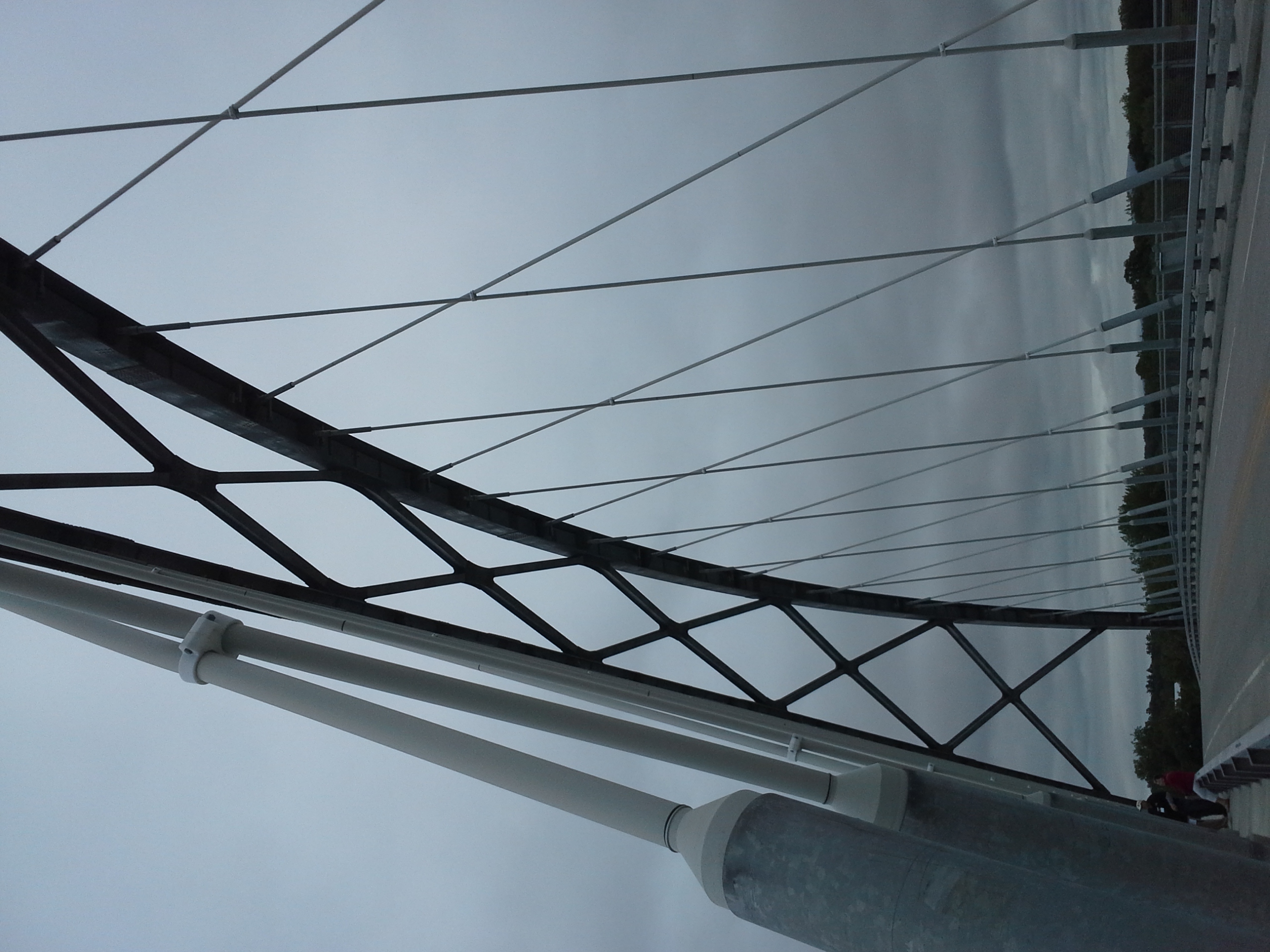Network Arch Bridge on:
[Wikipedia]
[Google]
[Amazon]
 A network arch bridge is a
A network arch bridge is a
 A network arch bridge is a
A network arch bridge is a tied arch bridge
A tied-arch bridge is an arch bridge in which the outward horizontal forces of the arch(es) caused by tension at the arch ends to a foundation are countered by equal tension of its own gravity plus any element of the total deck structure such grea ...
with inclined hangers that cross each other at least twice.
Structure
The inclined hangers with multiple intersections make the network arch bridge act like atruss
A truss is an assembly of ''members'' such as beams, connected by ''nodes'', that creates a rigid structure.
In engineering, a truss is a structure that "consists of two-force members only, where the members are organized so that the assembla ...
, with only axial compressible and tensile forces. Bending moments and shear forces are very small in network arches.
The hanger arrangement is what separates network tied arch structures from other types of tied arches, such as those with vertical hangers. It is defined by the number of hangers, hanger inclination and hanger distance. A radial hanger arrangement provides an efficient structure, as shown by Benjamin Brunn and Frank Schanack in 2003.Brunn B., Schanack F., Steimann U., (2004) “Network arches for railway bridges”, Arch Bridges IV, Advances in Assessment, Structural Design and Construction, P. Roca y C. Molins (Eds.), , pp. 671-680, Barcelona, Spanien In the radial hanger arrangement the distances between the upper hanger nodes and the angle between hangers and arch remain constant. In order to avoid too long hangers this angle may be increased towards the bridge ends.
History
The network arch idea was developed by the Norwegian engineer in the end of the 1950s.Advantages
Because both the arch and the tie are mainly subject to axial forces, their cross sections can be very small. Usually, transverse bending in the deck is bigger than bending in longitudinal direction. Therefore, a concrete deck that spans between the arches is a good solution for bridges with arch distances that are not too large. The concrete deck has longitudinal prestressing tendons in the arch planes.Difference to Nielsen-Lohse-Bridges
In Japan, tied arch bridges with crossing hangers are wrongly called Nielsen-Lohse bridge. Engineer Octavius F. Nielsen applied for a patent on tied arches with inclined hanger rods in 1926. This bridge type was then built about 60 times, primarily in Sweden. None of these bridges had crossed hangers. A drawback to the Nielsen type is that if there are dynamic loads on the bridge, the tension on some of these hangers may be reduced, even putting the hanger into compression. The network arch type, with multiple crossings, i.e. overlap in the horizontal axis, was developed by Per Tveit to avoid this. Lohse bridges have a tie conversely curved to the arch. The bridge deck is supported by a third structural element hanging underneath. They are named for the German engineer Hermann Lohse (1815–1893) who developed them in the late 19th century. The correct name of tied arch bridges with inclined hangers that cross each other at most once is Nielsen bridge. Tied arches with hangers with multiple intersections are network arch bridges. This strict rule is justified, because it leads to a more efficient structure.Examples
*, Norway (1963) * Fehmarnsund Bridge, Germany (1963) * Lake Champlain Bridge USA, 2011 *Providence River Bridge
Providence often refers to:
* Providentia, the divine personification of foresight in ancient Roman religion
* Divine providence, divinely ordained events and outcomes in Christianity
* Providence, Rhode Island, the capital of Rhode Island in th ...
, USA (2008)
*, Norway (1963)
* Blennerhassett Island Bridge, USA (2008)
*George C. King Bridge
The George C. King Bridge (formerly known as the St. Patrick's Island Bridge and colloquially known as the Skipping Stone Bridge) is a pedestrian bridge that spans the Bow River just northeast of Downtown Calgary, Alberta, Canada. The bridge conn ...
, Canada (2014)
* Troja Bridge, Prague, Czech Republic (2014)
*Bugrinsky Bridge
The Bugrinsky Bridge (russian: Бугри́нский мост, ''Bugrinsky Most'') is a road bridge over the Ob River in Novosibirsk, Russia
Russia (, , ), or the Russian Federation, is a transcontinental country spanning Eastern Europ ...
, Novosibirsk
Novosibirsk (, also ; rus, Новосиби́рск, p=nəvəsʲɪˈbʲirsk, a=ru-Новосибирск.ogg) is the largest city and administrative centre of Novosibirsk Oblast and Siberian Federal District in Russia. As of the 2021 Census, ...
, Siberia (2014)
*Ordsall Chord
Ordsall Chord, also known as the Castlefield Curve, is a short railway line in Ordsall, Salford, England, which links and Manchester Oxford Road to , designed to increase capacity and reduce journey times into and through Manchester. It allow ...
, United Kingdom (2017).
References
External links
{{Commons category, Network arch bridges * http://www.network-arch.com (Information on network arch bridges) * http://home.uia.no/pert/ (Information on network arch bridges by Per Tveit) * http://www.pineapplestudios.com/IWAYSite (Information on the construction of Providence River Bridge) Arch bridges